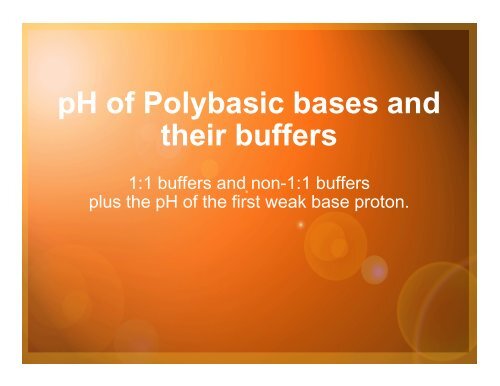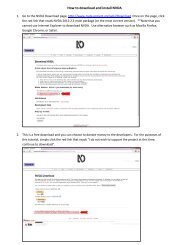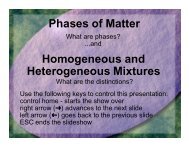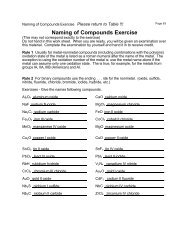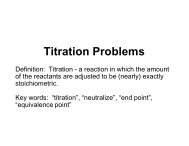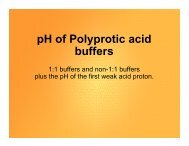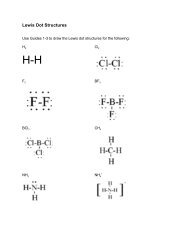pH of Polybasic acid buffers
pH of Polybasic acid buffers
pH of Polybasic acid buffers
Create successful ePaper yourself
Turn your PDF publications into a flip-book with our unique Google optimized e-Paper software.
<strong>pH</strong> <strong>of</strong> <strong>Polybasic</strong> bases and<br />
their <strong>buffers</strong><br />
1:1 <strong>buffers</strong> and non-1:1 <strong>buffers</strong><br />
plus the <strong>pH</strong> <strong>of</strong> the first weak base proton.
<strong>pH</strong> <strong>of</strong> <strong>Polybasic</strong> <strong>acid</strong> <strong>buffers</strong><br />
The concept <strong>of</strong> the equilibriums involve with polyprotic <strong>acid</strong>s<br />
and amphoteric bases has been presented in a previous slide<br />
show titled “Amphoteric (amphiprotic) <strong>acid</strong>s and bases”<br />
Please review this before continuing if you have not mastered<br />
the subject.
<strong>pH</strong> <strong>of</strong> <strong>Polybasic</strong> <strong>acid</strong> <strong>buffers</strong><br />
Here are some examples (from the previous slide show) <strong>of</strong><br />
polyprotic <strong>acid</strong>s along with their Ks.<br />
H 2 NNH 2 + H 2 O º H 2 NNH 3 + + OH ! K b1 = 1.2 × 10 –6<br />
H 2 NNH 3 + + H 2 O º H 3 NNH 3 2+ + OH ! K b2 = 8.9 × 10 -16<br />
H 2 N(CH 2 ) 6 NH 2 + H 2 O º H 2 N(CH 2 ) 6 NH 3 + + OH ! K b1 = 7.2 × 10 –3<br />
H 2 N(CH 2 ) 6 NH 3 + + H 2 O º H 3 N(CH 2 ) 6 NH 3 2+ + OH ! K b2 = 5.8 × 10 -4<br />
H 2 N(CH 2 ) 2 NH 2 + H 2 O º H 2 N(CH 2 ) 2 NH 3 + + OH ! K b1 = 5.2 × 10 –4<br />
H 2 N(CH 2 ) 2 NH 3 + + H 2 O º H 3 N(CH 2 ) 2 NH 3 2+ + OH ! K b2 = 3.7 × 10 -7<br />
H 2 N(CH 2 ) 3 NH 2 + H 2 O º H 2 N(CH 2 ) 3 NH 3 + + OH ! K b1 = 8.7 × 10 –4<br />
H 2 N(CH 2 ) 3 NH 3 + + H 2 O º H 3 N(CH 2 ) 3 NH 3 2+ + OH ! K b2 = 1.1 × 10 -5<br />
Given these data, calculate the <strong>pH</strong> <strong>of</strong> a 0.10 M solution <strong>of</strong> each<br />
<strong>of</strong> the pure bases. Answers are on the next slide.
<strong>pH</strong> <strong>of</strong> <strong>Polybasic</strong> <strong>acid</strong> <strong>buffers</strong><br />
Answers to the question, “What is the <strong>pH</strong> <strong>of</strong> each <strong>of</strong> the<br />
bases if they are made up to be 0.10 M?”<br />
H 2 NNH 2 pOH = 3.46 Y <strong>pH</strong> =10.54<br />
H 2 N(CH 2 ) 6 NH 2 pOH = 1.57 Y <strong>pH</strong> =12.43<br />
H 2 N(CH 2 ) 2 NH 2 pOH = 2.14 Y <strong>pH</strong> =11.86<br />
H 2 N(CH 2 ) 3 NH 2 pOH = 2.03 Y <strong>pH</strong> =11.97
<strong>pH</strong> <strong>of</strong> <strong>Polybasic</strong> <strong>acid</strong> <strong>buffers</strong><br />
Recall that for the 1:1 buffer, the pOH .pK b
<strong>pH</strong> <strong>of</strong> <strong>Polybasic</strong> <strong>acid</strong> <strong>buffers</strong><br />
Recall that for the 1:1 buffer, the <strong>pH</strong> .pK a<br />
Example 1: Calculate the <strong>pH</strong> <strong>of</strong> the buffer solution made up to<br />
be 0.10 M in H 2 NNH 2 and 0.10 M in H 2 NNH 3 Cl.
<strong>pH</strong> <strong>of</strong> <strong>Polybasic</strong> <strong>acid</strong> <strong>buffers</strong><br />
Recall that for the 1:1 buffer, the <strong>pH</strong> .pK a<br />
Example 1: Calculate the <strong>pH</strong> <strong>of</strong> the buffer solution made up to<br />
be 0.10 M in H 2 NNH 2 and 0.10 M in H 2 NNH 3 Cl.<br />
The two reactions associated with H 2 NNH 2 are:<br />
H 2 NNH 2 + H 2 O º H 2 NNH 3 + + OH !<br />
and H 2 NNH 3 + + H 2 O º H 3 NNH 3 2+ + OH !<br />
Which one should be used?
<strong>pH</strong> <strong>of</strong> <strong>Polybasic</strong> <strong>acid</strong> <strong>buffers</strong><br />
Recall that for the 1:1 buffer, the <strong>pH</strong> .pK a<br />
Example 1: Calculate the <strong>pH</strong> <strong>of</strong> the buffer solution made up to<br />
be 0.10 M in H 2 NNH 2 and 0.10 M in H 2 NNH 3 Cl.<br />
The two reactions associated with H 2 NNH 2 are:<br />
H 2 NNH 2 + H 2 O º H 2 NNH 3 + + OH !<br />
and H 2 NNH 3 + + H 2 O º H 3 NNH 3 2+ + OH !<br />
Which one should be used?<br />
Notice that H 2 NNH 2 and H 2 NNH 3 + are relevant.<br />
(Cl – ions are spectator ions. If this is mysterious to you (tish,<br />
tish), see the CHEM 1110 slide show “Overall versus Net<br />
Ionic Reactions” for a review!)
<strong>pH</strong> <strong>of</strong> <strong>Polybasic</strong> <strong>acid</strong> <strong>buffers</strong><br />
Recall that for the 1:1 buffer, the <strong>pH</strong> .pK a<br />
Example 1: Calculate the <strong>pH</strong> <strong>of</strong> the buffer solution made up to<br />
be 0.10 M in H 2 NNH 2 and 0.10 M in H 2 NNH 3 Cl.<br />
The two reactions associated with H 2 NNH 2 are:<br />
H 2 NNH 2 + H 2 O º H 2 NNH 3 + + OH !<br />
and H 2 NNH 3 + + H 2 O º H 3 NNH 3 2+ + OH !<br />
Which one should be used?<br />
Notice that H 2 NNH 2 and H 2 NNH 3 + are relevant.<br />
Since this is a 1:1 buffer, one need only set the pOH to the<br />
pK b<br />
Kb1 = 1.2 × 10 –6<br />
ˆ pOH = 5.92 Y <strong>pH</strong> = 8.08
<strong>pH</strong> <strong>of</strong> <strong>Polybasic</strong> <strong>acid</strong> <strong>buffers</strong><br />
Recall that for the 1:1 buffer, the <strong>pH</strong> .pK a<br />
Example 1: Calculate the <strong>pH</strong> <strong>of</strong> the buffer solution made up to<br />
be 0.10 M in H 2 NNH 2 and 0.10 M in H 2 NNH 3 Cl.<br />
The two reactions associated with H 2 NNH 2 are:<br />
H 2 NNH 2 + H 2 O º H 2 NNH 3 + + OH !<br />
and H 2 NNH 3 + + H 2 O º H 3 NNH 3 2+ + OH !<br />
Which one should be used?<br />
Notice that H 2 NNH 2 and H 2 NNH 3 + are relevant.<br />
Since this is a 1:1 buffer, one need only set the pOH to the<br />
pK b<br />
Kb1 = 1.2 × 10 –6
<strong>pH</strong> <strong>of</strong> <strong>Polybasic</strong> <strong>acid</strong> <strong>buffers</strong><br />
Recall that for the 1:1 buffer, the <strong>pH</strong> .pK a<br />
Example 1: Calculate the <strong>pH</strong> <strong>of</strong> the buffer solution made up to<br />
be 0.10 M in H 2 NNH 2 and 0.10 M in H 2 NNH 3 Cl.<br />
The two reactions associated with H 2 NNH 2 are:<br />
H 2 NNH 2 + H 2 O º H 2 NNH 3 + + OH !<br />
and H 2 NNH 3 + + H 2 O º H 3 NNH 3 2+ + OH !<br />
Which one should be used?<br />
Notice that H 2 NNH 2 and H 2 NNH 3 + are relevant.<br />
Since this is a 1:1 buffer, one need only set the pOH to the<br />
pK b<br />
Kb1 = 1.2 × 10 –6<br />
ˆ pOH = 5.92 Y <strong>pH</strong> = 8.08
<strong>pH</strong> <strong>of</strong> <strong>Polybasic</strong> <strong>acid</strong> <strong>buffers</strong><br />
Here’s some more examples, determine the answers:<br />
Example 2: Calculate the <strong>pH</strong> <strong>of</strong> a solution made up to be<br />
0.10 M in H 2 N(CH 2 ) 6 NH 3 Cl and 0.10 M in H 3 N(CH 2 ) 6 NH 3 Cl 2 .<br />
Example 3: Calculate the <strong>pH</strong> <strong>of</strong> a solution made up to be<br />
0.50 M in H 2 N(CH 2 ) 2 NH 2 and 0.50 M in H 2 N(CH 2 ) 2 NH 3 Cl .<br />
Example 4: Calculate the <strong>pH</strong> <strong>of</strong> a solution made up to be<br />
0.35 M in H 2 N(CH 2 ) 3 NH 3 Br and 0.35 M in H 3 N(CH 2 ) 3 NH 3 Br 2 .<br />
The answers are on the next slide.
<strong>pH</strong> <strong>of</strong> <strong>Polybasic</strong> <strong>acid</strong> <strong>buffers</strong><br />
Here’s some more examples, determine the answers:<br />
Example 2: Calculate the <strong>pH</strong> <strong>of</strong> a solution made up to be<br />
0.10 M in H 2 N(CH 2 ) 6 NH 3 Cl and 0.10 M in H 3 N(CH 2 ) 6 NH 3 Cl 2 .<br />
Answer: <strong>pH</strong> = pK b2 ˆ pOH = 3.24 Y <strong>pH</strong> = 10.76<br />
Example 3: Calculate the <strong>pH</strong> <strong>of</strong> a solution made up to be<br />
0.50 M in H 2 N(CH 2 ) 2 NH 2 and 0.50 M in H 2 N(CH 2 ) 2 NH 3 Cl .<br />
Answer: <strong>pH</strong> = pK b1 ˆ pOH = 3.28 Y <strong>pH</strong> = 10.72<br />
Example 4: Calculate the <strong>pH</strong> <strong>of</strong> a solution made up to be<br />
0.35 M in H 2 N(CH 2 ) 3 NH 3 Br and 0.35 M in H 3 N(CH 2 ) 3 NH 3 Br 2 .<br />
Answer: <strong>pH</strong> = pK b2 ˆ pOH = 4.96 Y <strong>pH</strong> = 9.04<br />
These are all 1:1 buffer so <strong>pH</strong> .pK a is OK.
<strong>pH</strong> <strong>of</strong> <strong>Polybasic</strong> <strong>acid</strong> <strong>buffers</strong><br />
What if the mixture is not a 1:1 buffer?<br />
Example 5: Calculate the <strong>pH</strong> <strong>of</strong> a solution made up to be<br />
0.10 M in H 2 N(CH 2 ) 2 NH 3 Cl and 0.50 M in H 3 N(CH 2 ) 2 NH 3 Cl 2 .
<strong>pH</strong> <strong>of</strong> <strong>Polybasic</strong> <strong>acid</strong> <strong>buffers</strong><br />
What if the mixture is not a 1:1 buffer?<br />
Example 5: Calculate the <strong>pH</strong> <strong>of</strong> a solution made up to be<br />
0.10 M in H 2 N(CH 2 ) 2 NH 3 Cl and 0.50 M in H 3 N(CH 2 ) 2 NH 3 Cl 2 .<br />
So, which <strong>of</strong> these reactions is relevant?<br />
H 2 N(CH 2 ) 2 NH 2 + H 2 O º H 2 N(CH 2 ) 2 NH 3 + + OH ! K b1 = 5.2 × 10 –4<br />
H 2 N(CH 2 ) 2 NH 3 + + H 2 O º H 3 N(CH 2 ) 2 NH 3 2+ + OH ! K b2 = 3.7 × 10 -7
<strong>pH</strong> <strong>of</strong> <strong>Polybasic</strong> <strong>acid</strong> <strong>buffers</strong><br />
What if the mixture is not a 1:1 buffer?<br />
Example 5: Calculate the <strong>pH</strong> <strong>of</strong> a solution made up to be<br />
0.10 M in H 2 N(CH 2 ) 2 NH 3 Cl and 0.50 M in H 3 N(CH 2 ) 2 NH 3 Cl 2 .<br />
So, which <strong>of</strong> these reactions is relevant?<br />
H 2 N(CH 2 ) 2 NH 2 + H 2 O º H 2 N(CH 2 ) 2 NH 3 + + OH ! K b1 = 5.2 × 10 –4<br />
H 2 N(CH 2 ) 2 NH 3 + + H 2 O º H 3 N(CH 2 ) 2 NH 3 2+ + OH ! K b2 = 3.7 × 10 -7<br />
It is the second reaction.
<strong>pH</strong> <strong>of</strong> <strong>Polybasic</strong> <strong>acid</strong> <strong>buffers</strong><br />
What if the mixture is not a 1:1 buffer?<br />
Example 5: Calculate the <strong>pH</strong> <strong>of</strong> a solution made up to be<br />
0.10 M in H 2 N(CH 2 ) 2 NH 3 Cl and 0.50 M in H 3 N(CH 2 ) 2 NH 3 Cl 2 .<br />
H 2 N(CH 2 ) 2 NH 3 + + H 2 O º H 3 N(CH 2 ) 2 NH 3 2+ + OH ! K b2 = 3.7 × 10 -7
<strong>pH</strong> <strong>of</strong> <strong>Polybasic</strong> <strong>acid</strong> <strong>buffers</strong><br />
What if the mixture is not a 1:1 buffer?<br />
Example 5: Calculate the <strong>pH</strong> <strong>of</strong> a solution made up to be<br />
0.10 M in H 2 N(CH 2 ) 2 NH<br />
x 3 Cl and 0.50 M in H 3 N(CH 2 ) 2 NH 3 Cl 2 .<br />
H 2 N(CH 2 ) 2 NH + 3 + H 2 O º H 3 N(CH 2 ) 2 NH 2+ 3 + OH ! K b2 = 3.7 × 10 -7<br />
This then is a normal type II buffer problem. Set up a table:<br />
[H 2 N(CH 2 ) 2 NH + 3 ]<br />
[OH – ]<br />
[H 3 N(CH 2 ) 2 NH 2+ 3 ]<br />
before equilibrium after equilibrium<br />
0.10<br />
0.0<br />
0.10 ! x<br />
x<br />
0.50<br />
0.50 + x
<strong>pH</strong> <strong>of</strong> <strong>Polybasic</strong> <strong>acid</strong> <strong>buffers</strong><br />
What if the mixture is not a 1:1 buffer?<br />
Example 5: Calculate the <strong>pH</strong> <strong>of</strong> a solution made up to be<br />
0.10 M in H 2 N(CH 2 ) 2 NH 3 Cl and 0.50 M in H 3 N(CH 2 ) 2 NH 3 Cl 2 .<br />
x<br />
H 2 N(CH 2 ) 2 NH + 3 + H 2 O º H 3 N(CH 2 ) 2 NH 2+ 3 + OH ! K b2 = 3.7 × 10 -7<br />
This then is a normal type II buffer problem. Set up a table:<br />
[H 2 N(CH 2 ) 2 NH + 3 ]<br />
[OH – ]<br />
[H 3 N(CH 2 ) 2 NH 2+ 3 ]<br />
before equilibrium<br />
0.10<br />
0.0<br />
0.50<br />
after equilibrium<br />
0.10 ! x<br />
x<br />
0.50 + x<br />
Fill in the<br />
equilibrium<br />
expression:<br />
K b<br />
− 2+<br />
⎡OH<br />
⎤⎡H3N(CH 2) 2NH<br />
⎤<br />
3<br />
=<br />
⎣ ⎦⎣ ⎦<br />
+<br />
⎡<br />
⎣HN(CH)NH<br />
⎤<br />
2 2 2 3⎦
<strong>pH</strong> <strong>of</strong> <strong>Polybasic</strong> <strong>acid</strong> <strong>buffers</strong><br />
What if the mixture is not a 1:1 buffer?<br />
Example 5: Calculate the <strong>pH</strong> <strong>of</strong> a solution made up to be<br />
0.10 M in H 2 N(CH 2 ) 2 NH 3 Cl and 0.50 M in H 3 N(CH 2 ) 2 NH 3 Cl 2 .<br />
x<br />
H 2 N(CH 2 ) 2 NH + 3 + H 2 O º H 3 N(CH 2 ) 2 NH 2+ 3 + OH ! K b2 = 3.7 × 10 -7<br />
This then is a normal type II buffer problem. Set up a table:<br />
[H 2 N(CH 2 ) 2 NH + 3 ]<br />
[OH – ]<br />
[H 3 N(CH 2 ) 2 NH 2+ 3 ]<br />
before equilibrium after equilibrium<br />
0.10<br />
0.0<br />
0.10 ! x<br />
x<br />
0.50<br />
0.50 + x<br />
Fill in the<br />
equilibrium<br />
expression:<br />
( x)( x)<br />
( 0.10 − x)<br />
− 7<br />
0.50 +<br />
3.5× 10 =
<strong>pH</strong> <strong>of</strong> <strong>Polybasic</strong> <strong>acid</strong> <strong>buffers</strong><br />
What if the mixture is not a 1:1 buffer?<br />
Example 5: Calculate the <strong>pH</strong> <strong>of</strong> a solution made up to be<br />
0.10 M in H 2 N(CH 2 ) 2 NH 3 Cl and 0.50 M in H 3 N(CH 2 ) 2 NH 3 Cl 2 .<br />
x<br />
H 2 N(CH 2 ) 2 NH + 3 + H 2 O º H 3 N(CH 2 ) 2 NH 2+ 3 + OH ! K b2 = 3.7 × 10 -7<br />
This then is a normal type II buffer problem. Set up a table:<br />
[H 2 N(CH 2 ) 2 NH + 3 ]<br />
[OH – ]<br />
[H 3 N(CH 2 ) 2 NH 2+ 3 ]<br />
before equilibrium after equilibrium<br />
0.10<br />
0.0<br />
0.10 ! x<br />
x<br />
0.50<br />
0.50 + x<br />
Fill in the<br />
equilibrium<br />
expression:<br />
( x)( x)<br />
( 0.10 − x)<br />
− 7<br />
0.50 +<br />
3.5× 10 =<br />
and solve*: x = 7.0 × 10 -8<br />
or: pOH = 7.15 Y <strong>pH</strong> = 6.85<br />
* the approximation ±x works here.
<strong>pH</strong> <strong>of</strong> <strong>Polybasic</strong> bases and<br />
their <strong>buffers</strong><br />
1:1 <strong>buffers</strong> and non-1:1 <strong>buffers</strong><br />
plus the <strong>pH</strong> <strong>of</strong> the first weak base proton.<br />
THE END


